Advertisements
Advertisements
प्रश्न
How does the angle of deviation produced by a prism change with increase in the angle of incidence. Draw a curve showing the variation in the angle of deviation with the angle of incidence at a prism surface.
उत्तर १
As the angle of incidence increases, the angle of deviation decreases first and reaches to a minimum value (δm) for a certain angle of incidence. By further increasing the angle of incidence, the angle of deviation is found to increase.
Variation of angle of deviation (δ) with angle of incidence(i):
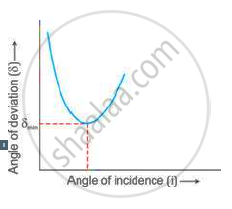
उत्तर २
The deviation angle first increases with increasing incidence angle and then decreases. From figure,
δ = δ1 + δ2 ....(i)
and i = δ1 +γ1 ; e = δ2 +γ2
⇒ i = γ1 = δ1 ....(ii)
⇒ e - γ1 = δ2 ....(iii)
from ΔON1 N2
γ1 +γ2 + ∠N1 ON2=180° ....(iv)
from cyclic quadrilateral
∠A + ∠N1ON2 = 180° ....(v)
from (iv) and (v)
γ1 +γ2 = A
δ = i - γ1 + e - γ2
=( i - e) - (γ1 + γ2) ...(vi)
at δm ;
i = e ; γ1 = γ2= γ
δm =2i - A ...(vii)
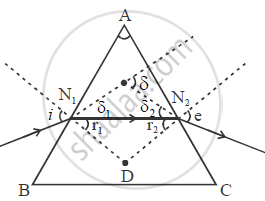
The variation in the angle of deviation with the angle of incidence at a prism surface
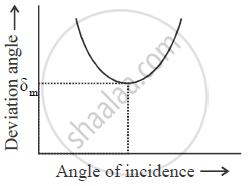
Graph between i and δm
APPEARS IN
संबंधित प्रश्न
Select from the following the best experimental setup for tracing the path of a ray of light passing through a rectangular glass slab.

(a) P
(b) Q
(c) R
(d) S
Which of the above wavelengths has a higher frequency?
What do you understand by the statement the refractive index of glass is 1.5 for white light?
The diagram alongside shows the refraction of a ray of light from air to a liquid.
- Write the values of (i) angle of incidence, (ii) angle of refraction.
- Use Snell’s law to find the refractive index of liquid with respect to air.

Rahim recorded the following sets of observations while tracing the path of a ray of light passing through a rectangular glass slab for different angles of incidence.
|
S. No. |
Angle of incidence |
Angle of refraction |
Angle of emergence |
|
I |
45° |
41° |
45° |
|
II |
40° |
38° |
38° |
|
III |
45° |
41° |
40° |
|
IV |
41° |
45° |
41° |
The correct observation is recorded at serial number:
(1) I
(2) II
(3) III
(4) IV
Using the curve, how do you infer that for given prism, the angle of minimum deviation δmin is unique for the given light?

In the diagram below, PQ is a ray of light incident on a rectangular glass block.
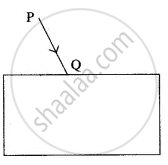
How are the angles ‘i’ and ‘e’ related to each other?
Two parallel rays of Red and Violet travelling through the air, meet the air-glass boundary as shown in the above figure. Will their paths inside the glass be parallel? Give a reason for your answer.
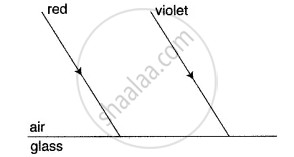
Light passes through a rectangular glass slab and through a triangular glass prism. In what way does the direction of the two emergent beams differ and why?
A glass block is having refractive index 3/2, the light ray is incident at an angle 45°. Find the sine of the angle of, refraction inside the glass block.
